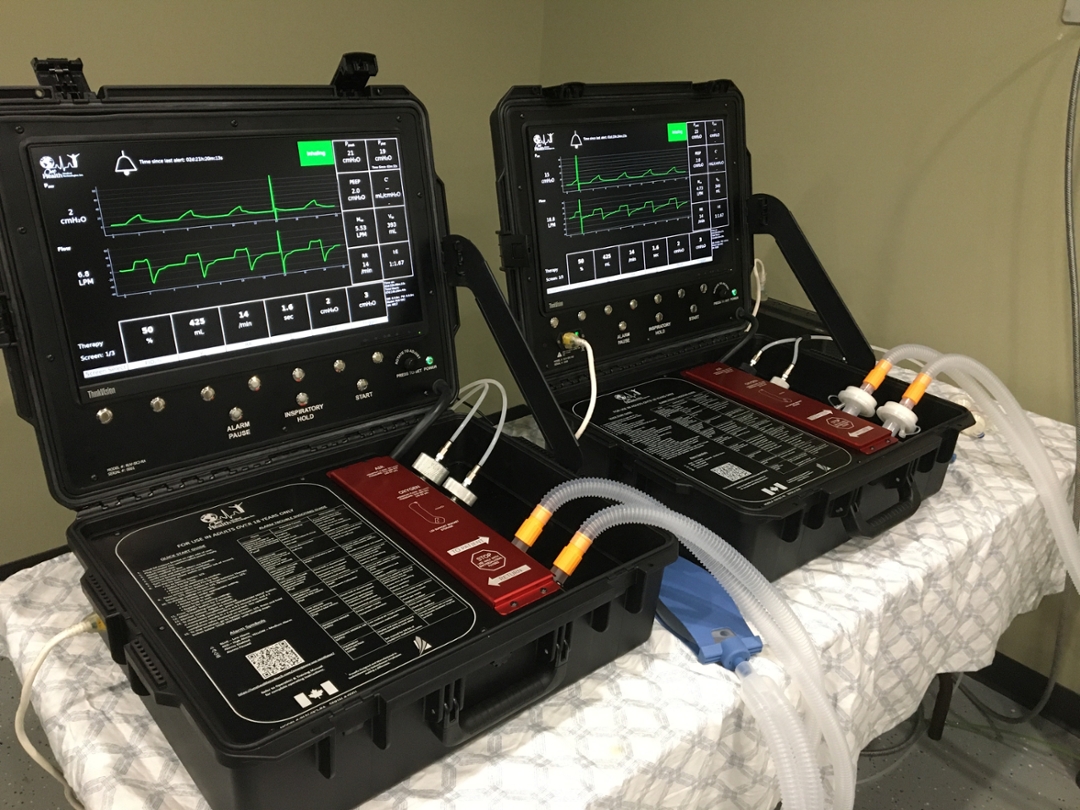
USask partners on made-in-Saskatchewan ventilator project
University of Saskatchewan Engineering was one part of the collaboration between USask and Saskatoon-based RMD Engineering Inc.
By USask Communications and the Saskatchewan Ministry of HealthOne hundred made-in-Saskatchewan ventilators will soon be available to support the needs of the province’s residents, thanks to an innovative collaboration among the University of Saskatchewan (USask), the Saskatchewan Health Authority (SHA), and Saskatoon-based RMD Engineering Inc.
The three organizations worked together, providing applied subject matter expertise, research and entrepreneurship to pave the way for RMD Engineering to successfully prototype an emergency use ventilator, dubbed the EUV-SK1.
RMD Engineering’s subsidiary, One Health Medical Technologies, recently received COVID-19 Medical Device Authorization from Health Canada for the in-house designed, developed and manufactured ventilator. Collaborating with USask and SHA subject matter experts, RMD Engineering was able to successfully prototype an emergency use ventilator (EUV-SK1) for Health Canada certification.
Support came from several colleges and units across USask, including the College of Engineering.
"This has been an incredibly exciting engineering project. The level of innovation and multidisciplinary collaboration has been exceptional and RMD president Jim Boire set the bar high for all of us. I’m thrilled to have had the chance to advance innovation in our province, and to meet a critical need for our community," said Suzanne Kresta, dean of the College of Engineering. "We are all excited and proud that the EUV-SK1 has achieved Health Canada certification."
This approval now paves the way for One Health Medical Technologies to sell their ventilator to the SHA and the Canadian health care market. The company is in the process of ramping up for production and this will include hiring 15 to 20 additional staff.
Jim Boire, president of the RMD Engineering Group of Companies and a USask Engineering alumnus, said he was grateful for the “high level of trust” in his company from the SHA, USask Engineering and the College of Medicine, which has led to a “world-class collaboration.”
“When COVID hit, my daughter, a Royal University Hospital intensive care nurse, raised awareness of the potential impact on the healthcare system. Knowing we had the skill set, capability, and capacity in-house, we chose to do something, rather than nothing, and created an emergency use ventilator using reliable technology and readily available materials,” said Boire (BE 1996, Mechanical).
The Saskatchewan government has given the SHA approval to purchase 100 EUV-SK1 ventilators for patients who need them across the province, adding to the ventilators already earmarked for its COVID-19 response. RMD’s One Health Medical Technologies expects to have the first 20 ventilators ready for delivery by Dec. 7. They would be used in SHA acute care facilities where most needed.
The EUV-SK1 is portable and can be moved to the area of greatest need. It is intended for ventilator-dependent adult COVID-19 patients for use in traditional health care facilities and spaces converted for the care of COVID-19 patients.
“We are delighted to have played a key role in supporting RMD’s development of this innovative and locally sourced technology that will help save lives and create jobs in Saskatchewan,” said USask Vice-President Research Karen Chad. “This success is the result of a visionary company, a health region, and a top research university with expertise in many fields working together to help meet the critical needs of the province and the world.”
USask provided support to RMD, which employs many engineering alumni, and worked with the SHA in various ways, including:
- College of Engineering Dean Kresta supported the project in its initial stages, so the college could lend equipment to create parts for the ventilator prototypes and provide expertise to lay out the ventilator’s electrical circuit board. RMD hired six engineering summer students to help ready the machines for assembly, and recent engineering grads are currently working at RMD.
- College of Medicine Dean Preston Smith has supported the project. The SHA and College of Medicine professor Dr. Mateen Raazi, who is also SHA head of anesthesiology, collaborated to bring in respiratory therapists and clinicians to test the machine and provide their feedback.
- The Western College of Veterinary Medicine’s Julia Montgomery, who is a respiratory subject matter expert, helped with writing the operation manual, testing of the machine function, the training video and the usability study.
- College of Law professor Patricia Farnese helped with regulatory work on standards for medical devices related to the Health Canada submission.
- USask Respiratory Research Centre members (director Donna Goodridge and an ICU nursing graduate student, Rebecca Erker) wrote the ventilator training manual.
- RMD team members had taken Edwards School of Business executive education courses on project management and executive leadership that were invaluable in carrying out the project efficiently and effectively under tight timelines.
“This initiative exemplifies the spirit of collaboration and entrepreneurship we’re so proud of in our province,” said Health Minister Paul Merriman. “Our government fully supports this work, and we are pleased that residents in Saskatchewan and across the country will have access to this equipment if they need it.”
“The SHA is grateful for the dedication and work that RMD Engineering has invested in creating a Saskatchewan-made solution to support the needs of patients for ventilator support as the COVID-19 pandemic continues. Enhancing our ventilator capacity allows for frontline teams to balance the needs of their patients with the appropriate available equipment,” said Lori Garchinski, SHA executive director of provincial programs – tertiary care.

